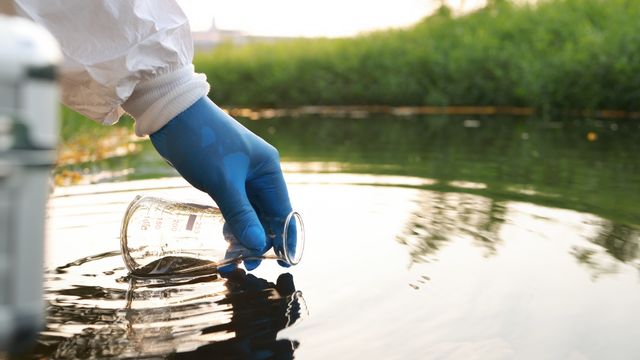It’s a mighty enough task for one country to monitor its levels of environmental pollution; it’s a colossal effort to do so for a whole continent. And yet that’s what the European Environment Agency (EEA) does.
Since its formation in 1993, the European Union (EU) agency has been studying and recording environmental data sampled from across member states and beyond, from Reykjavik to Ankara. These data are then presented to the political leadership of the union to inform environmental policy.
So, what is the current environmental state of Europe? Which contaminants are on the rise, and which are being successfully managed? Technology Networks spoke to Gerardo Sanchez, an expert on the environment and human health at the EEA, to find out.
Leo Bear-McGuinness (LBM):

Science Writer & Editor
Technology Networks
Leo is a science writer with a focus on environmental and food research. He holds a bachelor’s degree in biology from Newcastle University and a master’s degree in science communication from the University of Edinburgh.
Could you outline your work and that of the EEA?
Gerardo Sanchez (GS):

Expert in the environment and human health
An expert in the environment and human health at the European Environment Agency.
I’m a senior expert on health environment and wellbeing at the EEA. Prior to that, I have been for most of my career at the World Health Organization doing similar things in terms of what the EEA does.
The EEA is an independent agency of the EU. The independent part is very important because that’s what gives us our credibility. We are based in Copenhagen and are currently about 300 people, but our real reach comes from our networks with organizations in other countries; we have groups with many hundreds of experts in every country of the EU and also cooperating countries, such as in the Western Balkans and Turkey.
The main areas of our work concern the environment, climate change and health. In both areas, we have those collaborations that work with us and are also contracted by us to do analysis – which are really at the cutting edge of the health impact assessment of these pollutants and climate change. We do a lot of analysis of the data that is generated and comes to us from the countries.
LBM:

Science Writer & Editor
Technology Networks
Leo is a science writer with a focus on environmental and food research. He holds a bachelor’s degree in biology from Newcastle University and a master’s degree in science communication from the University of Edinburgh.
When it comes to pollutants, have you had a fresh focus in recent years? Are there any emerging pollutants of interest that you’ve begun analyzing?
GS:

Expert in the environment and human health
An expert in the environment and human health at the European Environment Agency.
We have been looking at the most important air pollutants for many years – since the foundation of the agency in 1992 – and those are the pollutants that, from what we know, cause the largest impact on the health of Europeans. Pollutants like particulate matter, specifically ultra-fine particles, as well as ozone and nitrogen dioxide. We look at these particles every step of the way, from how they are emitted from different sectors, specifically industrial emissions.
Under the EU Directive on Industrial Emissions, there is a very detailed overview of what larger industrial facilities can emit in terms of pollution to the air, water, and soil and that needs to be reported. In addition, all the information from a few years back is going to be gathered in the larger “State of the European Environment” report, which we do every five years. It’s like a complete overview of the state of the environment – pollution and health, and climate change and health are two parts of it.
We also look very closely at the effect of environmental noise. This is an often-overlooked pollutant, but, in Europe, it is the environmental risk that has the second-largest effect on health; such as people’s cardiovascular health, mental health and on children’s ability to concentrate and learn. [The noise primarily comes from] road traffic, aircraft industry and rail tracks, but particularly traffic noise has a very large impact on people’s health.
And then, in addition to that, we, of course, look at the health impacts of some toxic chemicals. In the media, there’s been justified attention to these forever chemicals, including, for instance, per- and polyfluoroalkyl substances (PFAS). The truth is, we are finding PFAS in concerning concentrations in many water bodies and samples in the environment, and the health effects of PFAS are more or less clear in terms of the diseases that they can contribute to. We don’t have enough data at the European level to come up with a full estimate of those impacts, but we have very good reasons to feel concerned about the presence of those chemicals in the environment and, importantly, in people’s bodies.
LBM:

Science Writer & Editor
Technology Networks
Leo is a science writer with a focus on environmental and food research. He holds a bachelor’s degree in biology from Newcastle University and a master’s degree in science communication from the University of Edinburgh.
How much of the EEA’s work is spent helping to devise new methods of detection for all these contaminants?
GS:

Expert in the environment and human health
An expert in the environment and human health at the European Environment Agency.
Some research projects on environment and health sometimes focus very heavily on the development of new methods or increasing sensitivity or specificity of methods. But oftentimes we would tell the researchers and the people who actually develop those new techniques that what would be really useful is to have more measurements in more places, to get a full overview of the actual risk this [pollutant] is posing. Because getting a two-decimal-point better measurement in a place that has already been measured thousands of times doesn’t really move the needle of policy. Our role is to try and steer research a little bit into more actionable areas, that will actually make a difference for people’s health.
LBM:

Science Writer & Editor
Technology Networks
Leo is a science writer with a focus on environmental and food research. He holds a bachelor’s degree in biology from Newcastle University and a master’s degree in science communication from the University of Edinburgh.
Could you give an example of such an actionable area of policy?
GS:

Expert in the environment and human health
An expert in the environment and human health at the European Environment Agency.
A clear example where we need much more data is noise. Under the European Environmental Noise Directive, it’s a small selection of cities that are actually mandated to send those data; the majority of the European Union countries are not covered by those measurements. So, that is something where we need big improvements.
In the case of air pollution, there is a very large air quality monitoring network, but also we have been able to, with validated measurements and models, downscale the areas of exposure down to 1-by-1 kilometer for the entire EU, and we are actually working to downscale it further to perhaps 100-by-100 meters. So, I think the measurement of that is a story of success.
LBM:

Science Writer & Editor
Technology Networks
Leo is a science writer with a focus on environmental and food research. He holds a bachelor’s degree in biology from Newcastle University and a master’s degree in science communication from the University of Edinburgh.
With all the data you have over the decades, what pollution trends have you seen?
GS:

Expert in the environment and human health
An expert in the environment and human health at the European Environment Agency.
The story of air pollution in Europe is, by and large, a story of success. But it’s not uniform; for some pollutants, it’s gone down very clearly and very steadily, and that is the case, for instance, with particulate matter. That is a very good thing, because particulate matter is a very dangerous pollutant. But, for others such as ozone, we haven’t seen the same trend, and ozone is something that is bound to get worse as the climate warms and solar radiation makes it more prevalent in particular areas in the south of Europe.
The EU has some goals of how pollution should decrease by 2030, and there was a recent assessment where they measured progress against those goals. For instance, the goal of reducing the health impacts of air pollution by 55% by 2030 was very well on track, whereas the one of reducing the chronic health effects from transport noise was not on track for 2030. So, it’s a little bit of a mixed story.
LBM:

Science Writer & Editor
Technology Networks
Leo is a science writer with a focus on environmental and food research. He holds a bachelor’s degree in biology from Newcastle University and a master’s degree in science communication from the University of Edinburgh.
What’s behind the reduction in air pollution? The general deindustrialization in Europe?
GS:

Expert in the environment and human health
An expert in the environment and human health at the European Environment Agency.
There’s an element of that. [There have been] technological improvements over the last three decades in terms of clean technologies, particularly in the automotive industry. Many analyses have shown that the pressure of the EU policies has actually significantly contributed to that, even though we’d like them to be even more stringent.
LBM:

Science Writer & Editor
Technology Networks
Leo is a science writer with a focus on environmental and food research. He holds a bachelor’s degree in biology from Newcastle University and a master’s degree in science communication from the University of Edinburgh.
You mentioned the EEA’s next report is due soon. Any hints as to its findings and recommendations?
GS:

Expert in the environment and human health
An expert in the environment and human health at the European Environment Agency.
There are no surprises in the upcoming report. I mean, most of what we’ve seen about pollution, including chemical pollution, air pollution and noise, has been said in very recent publications.
We would like more data, for instance, on noise, but I think, most importantly, we would like for many more countries and cities to have actual noise reduction plans that will reduce the exposure to very large populations. Then you’ll see health improvements.
LBM:

Science Writer & Editor
Technology Networks
Leo is a science writer with a focus on environmental and food research. He holds a bachelor’s degree in biology from Newcastle University and a master’s degree in science communication from the University of Edinburgh.
What would those improvements look like?
GS:

Expert in the environment and human health
An expert in the environment and human health at the European Environment Agency.
In different areas, it’s a little bit different. For instance, in the eastern part of Europe, part of the pollution proportion comes from both industrial sources and residential heating. But even if we were to say improve or electrify cars at a much higher rate, part of the road traffic noise would not be solved, as it is the wheels that make significant environmental noise. So, the solutions would have to be tailored to the specific location. In places where residential heating produces most of the pollution, then gasification or electrification at higher scales is something that could help. We’ve seen that in some countries, in the Balkans, for instance, with gasification efforts in North Macedonia and in other places.
LBM:

Science Writer & Editor
Technology Networks
Leo is a science writer with a focus on environmental and food research. He holds a bachelor’s degree in biology from Newcastle University and a master’s degree in science communication from the University of Edinburgh.
How does the second prime aspect of the EEA’s work – climate change – affect these pollution risks?
GS:

Expert in the environment and human health
An expert in the environment and human health at the European Environment Agency.
Climate change is bound to aggravate many of those exposures that we are talking about, in the case of ozone, for instance, but it will also affect water availability and even on the concentration of some chemicals in some water bodies. It’s a force that will aggravate many of those exposures.
The above content is a transcription of an interview with
Gerardo Sanchez conducted on September 18, 2025. It has been edited for clarity
and flow to ensure a better reading experience. While every effort has been
made to preserve the original content and meaning, some minor adjustments have
been made to improve readability.
